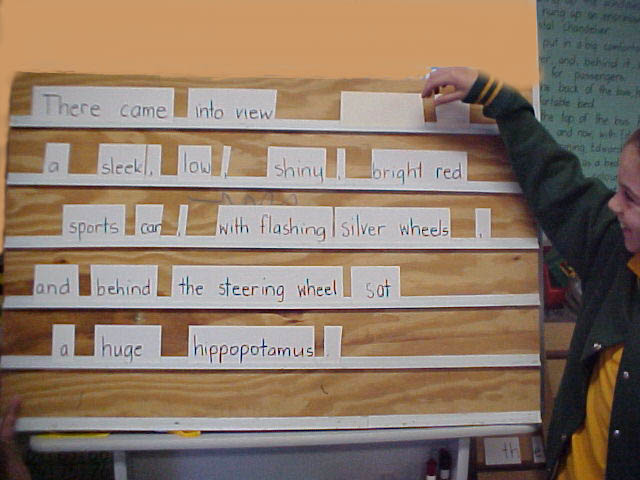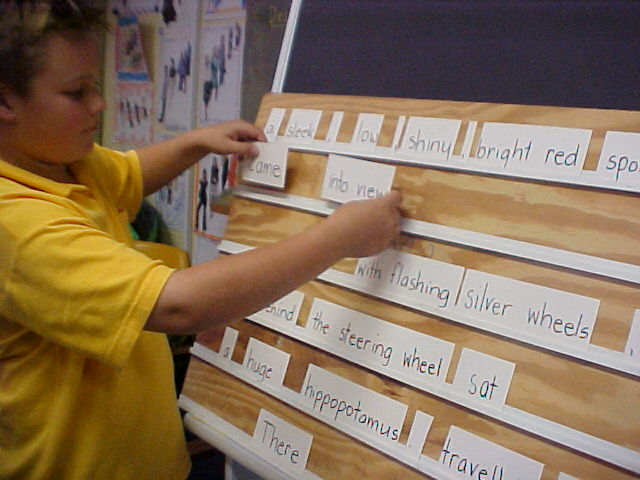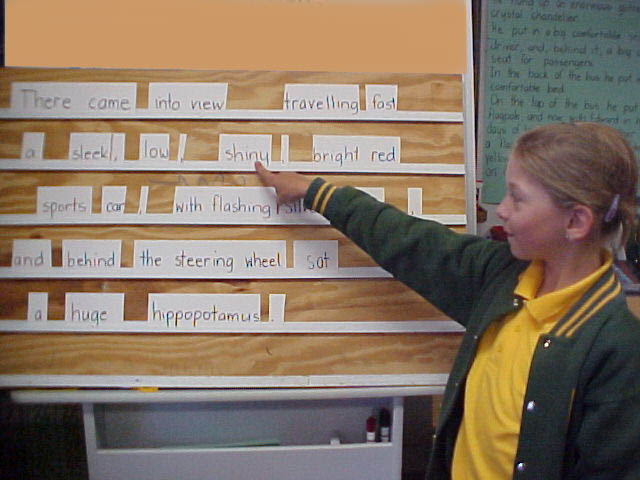Morris Lurie tells us a lot about this hippopotamus before he tells us what he looks like. First he tells us that he can be seen now, but that he wasn't there before. What words tell us that?
Teacher: Yes, 'There came into view' lets us know that the crowd could see something. Can anybody tell us why Morris Lurie wrote those words first?
Child: We find out about his car.
Child: At the end we find out he is huge.
Teacher: Yes, that's right, Morris Lurie wants to make huge dramatic, so he tells us other things first. The first thing he tells us is how he was moving
Teacher: Yes he was driving up to the platform fast. Can anybody tell us more about that?
Child: He was being a show-off to be travelling fast.
Teacher: Yes that's right, and he was selfish as well, because he didn't drive slowly to make sure the crowd was safe.
Teacher: Next we are told what came into view
| a sleek, low, shiny, bright red sports car. |
Teacher; Yes, you couldn't help noticing a car like that.
Child: It's shiny so people will notice it.
Child: It's sleek so it will go fast.
Child: Sports cars are low so they will go fast.
Child: He thinks he's special - a movie star or something.
Teacher: Yes, that's right. We can tell he thinks he's special by the kind of car he owns.
Teacher: Then 'with' lets us know that Morris Lurie is going to tell us even more about the car. What is the extra thing we are told about the car?
| with flashing silver wheels |
Child: You can see the lines in the picture to show that the wheels are flashing.
Child: Yes, and it makes the car look more special.
Teacher: Yes, you're both right. The flashing silver wheels make the car look more special. We've learnt a lot about the special car, that it's sleek, low, shiny and bight red and what it's wheels look like, but we don't know what the driver looks like yet.
Next Morris Lurie uses the word 'and' to let us know that there will be more information and then tells us where the person sat.
and behind the steering wheel sat
Teacher: Can anyone tell us more about that?
Child: We know he's the driver because he's sitting behind the steering wheel.
Child: He's driving fast
Teacher: Yes, you're both right. He is the driver and he is the one who is driving fast. Now we're going to learn who has come into view.
Teacher. Yes, at the end of the sentence we are told something about what the driver looks like, that he is huge. Who can tell us more about 'huge'?
Child: He's huge, so he might win the race.
Child: Sometimes good swimmers are big.
Child: We notice 'huge' because it comes at the end of the sentence. You read it like this…
Teacher: Yes, so this is someone who might beat Edward in the race. Morris Lurie has left it right to the end of the sentence to tell us he's huge, and that makes us notice those words better, it makes it very dramatic.
Add that this is the end of the sentence, ask how we know that and cut off the fullstop.
What the children have remembered:
That Morris Lurie makes us wait.
That it was showing off to travel fast.
That someone like a movie star would own such a car.
That Sebastian is a show-off.
That if the person is behind the steering wheel he is the driver.
That being huge means he might win the race.
That we notice 'huge' because it's at the end of the sentence.
New information that the teacher has imparted:
That Sebastian is selfish, not keeping the crowd safe.
That we can tell he thinks he's special by the kind of car he owns.
The sentence now looks like this
low, shiny,bright red sports car, | with flashing silver wheels, |
and behind the steering wheel | | |
.
|
You might begin your next session by asking what we know about this hippopotamus.
You could then add the information that we can work out what a character is like by being told what they own, what they do.
TURNING OVER SOME PHRASES TO DETERMINE THEIR FUNCTION

Indicate:
Encourage conversation about what that lets us know.
The conversation will include how he was travelling, that he was
showing off, that he wasn't being careful of the safety of others,
that it keeps us waiting to find out what came into view.
Turn the phrase over and have a volunteer read the new sentence.
| There came into view, | | a sleek, low, shiny, bright red sports car, |
| with flashing silver wheels, | and behind the steering wheel |
Ask does the sentence make sense.
Children may say it doesn't because they think the question means,
is this sentence right? Ask, can you understand the new sentence?
End up with the conclusion that we can understand the new sentence
but we no longer know how the car was travelling, and that the driver
didn't care about the safety of others, and that we're not kept so
long to know what came into view.
Reinstate
in the sentence.
Commas
Add that
is a separate part of the sentence, that we can understand the sentence
without it, that Lurie added those words to tell us special things,
and that that is why there are commas in front of and after those
words.
Cut off those two commas.
The sentence will now look like this:-
|
There came into view |
, |
travelling fast |
, |
|
| a sleek, low, shiny, bright red sports car, |
|
with flashing silver wheels, |
and behind the steering wheel |
sat |
Another example
Treat
|
with flashing silver wheels, |
in similar fashion.
The sentence will now look like this:-
|
There came into view |
, |
travelling fast |
, |
|
a sleek, low, shiny, bright red sports car |
, |
| with flashing silver wheels |
|
, |
and behind the steering wheel |
sat |
Now turn over both those phrases, including the commas.
|
There came into view |
| | | a sleek, low, shiny. bright red sports
car | |
|
| | and behind the steering wheel | sat | a huge hippopotamus | |
Ask volunteers to read.
Talk about the information omitted.
End by saying that when we don't have to wait so long to find out
what came into view, it is not so dramatic.
Turn all the cards right way round.
LOOKING AT WORD ORDER
This is another way we can show children that Lurie has made the entrance
dramatic, because the final position in the sentence emphasises the
last two words.
This is easier to do while the sentence still appears in groups of
words rather than as single words.

|
There came into view |
, | travelling fast
|
, |
| a sleek, low, shiny, bright red sports car | , |
| with flashing silver wheels | . | and behind the steering wheel |
sat |
, | a huge hippopotamus |
. |
Pick up
and say you are going to cut off 'there'. Do this, and put 'there'
at the bottom of the board.
Now move
to the beginning of the sentence.
The sentence will now read:-
| a huge hippopotamus | came into view |
, | travelling fast |
, |
| a sleek, low, shiny, bright red sports car |
|
, | with flashing silver wheels |
, | and behind the steering wheel | sat |
. |
Cut off 'a' and replace with 'A'.
Juggle the phrases to see if you can make a sensible sentence starting
with
and still retaining all the original information.
You may need to add or change words. When you do this, write the
new words on different colour card.
The following example also divides the original sentence into two.
Put the new fullstop on different colour card.
One new possibility is
| A huge hippopotamus | sat | behind the steering wheel | of | a sleek, low, shiny, bright red sports car |
. |
| He | came into view | travelling fast | . |
Let children experiment with as many different word orders as they
like.
Read the sentence before, then the new sentence, then the sentence
after.
Talk about whether the new sentence makes the new entrance sound
so dramatic.
You might like to have something mysteriously come into view in your
classroom and build up tension about what is inside it by meticulously
first describing the wrapping.
Remake the original sentence. Talk about the fact that the word order
in the sentence puts the emphasis on 'a huge hippopotamus'.
LOOKING AT PRECISE WORDS

We can now be more exact about
Show that 'travelling' tells what the car was doing, and 'fast'
tells how it was travelling.
We spent a lot of time on
| a sleek, low, shiny, bright red sports car |
First we established that 'sports' tells us what kind of car
this is. Show pictures of different kinds of cars eg sports, racing,
sedan, family. This is a classifying word.
Then we looked at the exact meaning of sleek, low, shiny and how
each of these tells something different about what the car looked
like. We call such words describing words.
We noted which words had a comma separating them and talked about
the reason - separating describing words.
Then we looked at bright red. We noticed that there is no comma between
bright and red. We worked out that bright is a word telling what kind
of red, that bright is a classifying word.
If there are any words still uncut, we cut them separately now.
We turned over words, eg 'sleek', one at a time, asked volunteers
to read the new sentence, then asked - 'Does the sentence still make
sense?' 'What information has been left out?' 'How is that information
important?' 'Why do you think Lurie put that word in his story?'
LOOKING AT JOINING WORDS
| a sleek, low, shiny, bright red sports car |
and
| behind the steering wheel |
After we had talked about these phrases (one at a time), we picked
up the joining word, and explained that it is a way of signalling
that more information coming. 'With' lets us know that the
car comes 'with' something else - that there is more to be
added to a description. 'And' lets us know that there is more
information in the sentence. We have found that joining words are
easiest to talk about after the meaning of each phrase is firmly established.
MOVING TO SPELLING
You now have word cards for spelling.
Make sure everyone can read these words out of context before you
proceed.
HOW TO PROCEED FROM HERE
After learning how to spell many words from these sentences, you move
to 'Easy spelling' where children practise spelling in context.
From there you make a writing plan, using keywords, and proceed to
reconstructed writing.
Back to Top